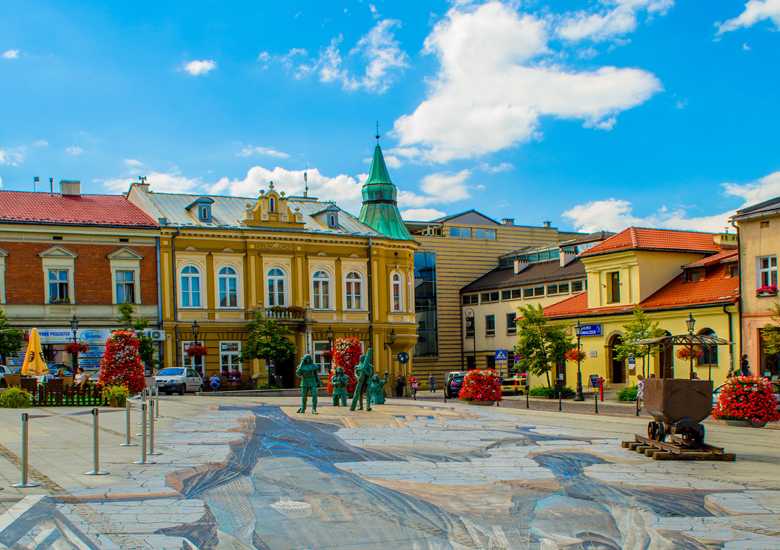Wieliczka is a town in southern Poland in the Krakow metropolitan area, and situated (since 1999) in Lesser Poland Voivodeship previously, it was in Krakow Voivodeship (1975–1998). The town was founded in 1290 by Duke Premislas II of Poland. Nowadays, it is mostly known for the Wieliczka Salt Mine, which was declared a UNESCO World Heritage Site in 1978. History : Medieval times : The first settlers were probably from the Celtic tribes. In later years they were driven out by the Slavic population. The importance of mining deposits arose after the capital of Poland was moved from Gniezno to Krakow by Casimir I the Restorer. Brewing brought huge revenues, which the prince needed to maintain the court and rebuild the destroyed country. Systematic development of the mining settlement stopped the Tartar invasion, which destroyed Krakow and surroundings.
After the 1252 discovery of salt and potassium deposits extraction of salt from deep regions in the earth began. In the year 1289, Henryk IV Probus, then Lord of Krakow issued a document authorising the brothers Jeskowi and Hysinboldowi to rule the town of Wieliczka. The next year Duke Przemysl II gave Wieliczka town privileges and in 1311, during the reign of Wladyslaw Lokietek, then General Secretary of Geslar de Kulpen joined the Rebellion of wojt Albert. After terminating the rebellion Albert fled to Silesia, where he served as Steward of Wieliczka. 17th to 18th century : In 1651 the Wieliczka population was decimated by a plague. In the years 1655-1660, at the time of the Swedish invasion, the city was in economic decline. The mine was plundered and burned by the Swedes. The Swedish crew guarded the mine and the taxes were raised upon the population. Gabriel Wojnillowicz alongside with Jerzy Sebastian Lubomirski proceeded to organize approximately 3,000 people which took part in the liberation of Wieliczka, Bochnia and Wisnicz. The battle took place in Kamionna, Lesser Poland Voivodeship, where the Poles attacked the hill, and referred their victory.
18th to 19th century : On 9 June 1772 the occupation of Wieliczka by the forces of the Austrian began. In 1809 Wieliczka was incorporated into the Duchy of Warsaw by the Austrians and so the Habsburgs regained the city after the fall of the Duchy and its partition by the Congress of Vienna. From then on the official German name Gross Salz became part of Galicia. In the time of the partition, unemployment arose because the Austrians brought modern equipment which caused a cease of production throughout the city and surrounding areas, due to low wages, forcing were dismiss en masse of Polish miners. That led to the arrival of German, Hungarian, Croatian and Transylvanian miners, changing so the ethnic composition of the city in favor of the immigrant population. After the outbreak of the uprising in 1846 in Krakow by Edward Dembowski, who became Secretary to Jan Tyssowski, the dictator of the revolution, the miners seized power in the Wieliczka salt mine. In the period of Galician autonomy there was a gradual development of the city. The mine became the largest in concentration of miners in Galicia. In the Nitra district, there were over 2000 workers employed.
20th to 21st century : Only by the end of the nineteenth century there was public housing development. The city expanded with private money, mining built colonies (settlement for families of mining workers), a salinarna power plant (supplied electricity not only to the mine, but also to the city). In the inter-war period, Wieliczkaites saw the development of territorial area, new residential districts were formed until a 1933 miners’ strike took place, due to the reduction of wages by 13%. On 7 September 1939 began the occupation of Poland by the German army, which entered the country through Slovakia. The city was crowded, as Wieliczka moved approximately 5.4 thousand people of Jewish origin to Krakow after the opening of the ghetto. On 21 January 1945 the Soviet army invaded Wieliczka. After World War II, began a period of systematic development of the city. In 1978 UNESCO decided to list Wielicka salt mine as a world cultural heritage. In 1994 the city was declared a historical monument.
Access : Coordinates: 49.983333, 20.066667 / It is easily accessible from Krakow by car, bus or train (the trip from Krakow should take around 30 minutes).MPK in Krakow buses 204, 244 (or 904 at night). Regional Bus Station in Krakow PKP – trains leave for Wieliczka Rynek Kopalnia at 20 and 40 minutes past the hour, and take 22 minutes
Attractions : Wieliczka salt mine, ul. Danilowicza 10, . April – October 07:30—19:30, November – March 08:00—17:00. A UNESCO World Heritage site.
2 Saltworks Museum (Zamek Zupny – Muzeum Zup Krakowskich Wieliczka), ul. Zamkowa 8, . Museum is in the castle. / Wooden churches
Go next : Bochnia / Bielsko-Biala / Tarnow / Nowy Sacz / Zakopane / Czestochowa / Wadowice / Krynica / Muszyna / Busko-Zdroj / Piwniczna / Zalipie

